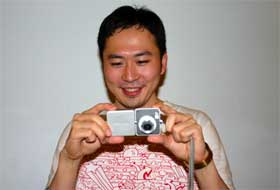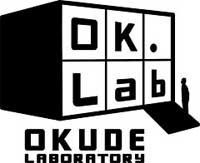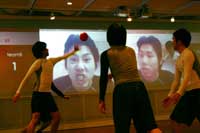 I met Takashi Matsumoto in a charming village somewhere in the Swiss Alps for the Collaborative Artefacts Interactive Furniture workshop. He was presenting a very exciting object called Z-agon, a small cube which is in fact a video player. Each face of the cube is an high-res display for multi-media contents (video). I then started to follow from afar the activities of the Keio University and discovered so many nice projects that i asked him if he'd have time to answer a few questions. Somehow, between a laptop battle, his research and maybe a couple of turntable sampling he managed to find a couple of hours to unveil what he and the other designers in his laboratories are working on.
I met Takashi Matsumoto in a charming village somewhere in the Swiss Alps for the Collaborative Artefacts Interactive Furniture workshop. He was presenting a very exciting object called Z-agon, a small cube which is in fact a video player. Each face of the cube is an high-res display for multi-media contents (video). I then started to follow from afar the activities of the Keio University and discovered so many nice projects that i asked him if he'd have time to answer a few questions. Somehow, between a laptop battle, his research and maybe a couple of turntable sampling he managed to find a couple of hours to unveil what he and the other designers in his laboratories are working on.
Can you tell us a few words about you? How did you get to work at Okude Lab? What is your role there?
First of all, I am really happy to get an interview for WMMNA! I am checking the feed everyday.
I am now a Ph.D. student of Keio University, Media Design Program and I belong to Okude Lab. In Shonan-Fujisawa Campus (SFC). I am designing user interfaces for network-based mobile gadgets. Those designs aim to provide simple embodied interactions for everyday objects to access web resources and to make our everyday lives more entertaining. My research interest is to produce an integrated design between hardwares, systems and business models for such devices.
My works like Z-agon and Pileus are futuristic but trying to be fit into a market right now. In my teenage years, I was living in Shibuya, a big commercial district in Tokyo. I have been watching how industries drop marketing to us, and I was aware of that there was a big chasm between product planning, marketing processes, and real user needs. So I studied marketing and intellectual properties in my undergraduate days. Then I realized we need a "design" of entire social and market systems to solve that problem. For example, Sony's Walkman and MTV were medias changed a market balance and our life styles in '80s music industry. I wanted to make such medias to change our life.
 Then, I moved to Okude Lab just before I went on to master's course. Okude Lab. is an interesting laboratory researching a media design with such a wider vision. It has been developing actual works but also concerning humans and social factors. It's recent research focuses are designs of embodied interactions and social systems of communication media products. Okude lab. have a design method of ethnography and prototyping skills of assorted technologies to make concepts of works. Now It's quite a big laboratory having 50 students (incl. undergraduates and graduates). Each work is designed in a collaborative team of 3 to 5 people. My works are also developed in a team.
Then, I moved to Okude Lab just before I went on to master's course. Okude Lab. is an interesting laboratory researching a media design with such a wider vision. It has been developing actual works but also concerning humans and social factors. It's recent research focuses are designs of embodied interactions and social systems of communication media products. Okude lab. have a design method of ethnography and prototyping skills of assorted technologies to make concepts of works. Now It's quite a big laboratory having 50 students (incl. undergraduates and graduates). Each work is designed in a collaborative team of 3 to 5 people. My works are also developed in a team.
Okude Lab is a member of Media Design Program of Keio University (a.k.a. KMD). KMD now has 10 laboratories and we are collaborating in a big research project named "Ubiquitous Content". I am also working as a research assistant for the Ubiquitous Content project.
What is Ubiquitous Content about? What does this expression mean? Which area does it cover exactly?
"Ubiquitous Content" is a project designated by a governmental grant of JST-CREST (Japan Science and Technology Corporation: Core Research for Evolutional Science and Technology). This is one of the biggest projects of KMD.
 "Ubiquitous Content" is an idea of a new design objective of our lives in the post-PC era. In 20th century, a notion of media contents has been meant contents like movies, music, animations, video games etc. Figuratively speaking, such contents were entities supplied in containers designed as "boxes". But now, a spread of networks and a
"Ubiquitous Content" is an idea of a new design objective of our lives in the post-PC era. In 20th century, a notion of media contents has been meant contents like movies, music, animations, video games etc. Figuratively speaking, such contents were entities supplied in containers designed as "boxes". But now, a spread of networks and a
realization of ubiquitous computing technologies are going to change those styles of media. The container is not like a "box" any more: It will change its forms freely to give us advanced computer augmentations in a specific context and it will be sometimes invisible embedded into our environments. It is more appropriately called Ubiquitous Media and it will be a new style of media. When we design such Ubiquitous Media, we need to think about the container as our environments in which many things are cooperating rather than a single hardware, a single software or a single standard. Users will not need to be conscious of those medias, therefore such containers emerge for users as "their lives" themselves. "Ubiquitous Contents" are contents for such media. Those must be "experiences" in "their lives".
As Ubiquitous Content project focuses on our lives and experiences, all things in our everyday lives are targets of the design. The 10 Laboratories of KMD are working on this wide subject from different perspectives.
For example, recent works of Ubiquitous Contents include the following topics: Yoshiro Sugano's ShootBall (Okude Lab) implemented a new sport using a ball with a built-in sensor and goals of visual projections. Midori Shibutani's Fabcell (Wakita Lab) is developing a new fabric changing colors for cyber fashions. Projects like a LivePic (M. Katsura for imgl; video) and BiblioRoll (Okude Lab) are introducing a new interaction techniques for both environmental and mobile media. It also includes research topics like Cyber Sound Project (Iwatake Lab) and New Ambience (Hiroya Tanaka Lab). Topics of Ubiquitous Contents are very wide.
Each design and research works from 10 laboratories are working separately under the concept of Ubiquitous Content. And we are collaborating together to make its design theory and a platform for the basis of Ubiquitous Content. Several a year, we hold demonstration events of Ubiquitous Content works together.


BiblioRoll and LivePic

